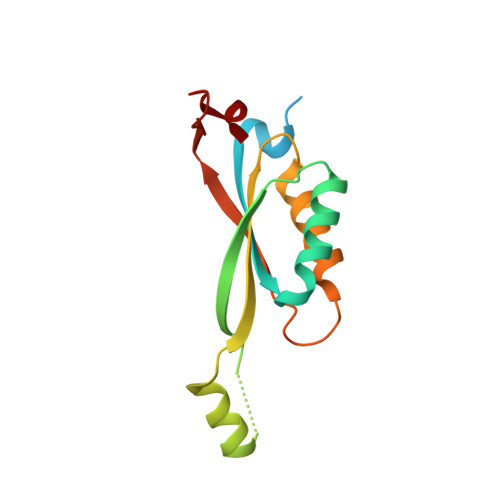The structure of a PII signaling protein from a halophilic archaeon reveals novel traits and high-salt adaptations.
Palanca, C., Pedro-Roig, L., Llacer, J.L., Camacho, M., Bonete, M.J., Rubio, V.(2014) FEBS J 281: 3299-3314
- PubMed: 24946894
- DOI: https://doi.org/10.1111/febs.12881
- Primary Citation of Related Structures:
4OZJ, 4OZL, 4OZN - PubMed Abstract:
To obtain insights into archaeal nitrogen signaling and haloadaptation of the nitrogen/carbon/energy-signaling protein PII, we determined crystal structures of recombinantly produced GlnK2 from the extreme halophilic archaeon Haloferax mediterranei, complexed with AMP or with the PII effectors ADP or ATP, at respective resolutions of 1.49 Å, 1.45 Å, and 2.60 Å. A unique trait of these structures was a three-tongued crown protruding from the trimer body convex side, formed by an 11-residue, N-terminal, highly acidic extension that is absent from structurally studied PII proteins. This extension substantially contributed to the very low pI value, which is a haloadaptive trait of H. mediterranei GlnK2, and participated in hexamer-forming contacts in one crystal. Similar acidic N-extensions are shown here to be common among PII proteins from halophilic organisms. Additional haloadaptive traits prominently represented in H. mediterranei GlnK2 are a very high ratio of small residues to large hydrophobic aliphatic residues, and the highest ratio of polar to nonpolar exposed surface for any structurally characterized PII protein. The presence of a dense hydration layer in the region between the three T-loops might also be a haloadaptation. Other unique findings revealed by the GlnK2 structure that might have functional relevance are: the adoption by its T-loop of a three-turn α-helical conformation, perhaps related to the ability of GlnK2 to directly interact with glutamine synthetase; and the firm binding of AMP, confirmed by biochemical binding studies with ATP, ADP, and AMP, raising the possibility that AMP could be an important PII effector, at least in archaea.
Organizational Affiliation:
Instituto de Biomedicina de Valencia of the CSIC (IBV-CSIC), Spain.
















